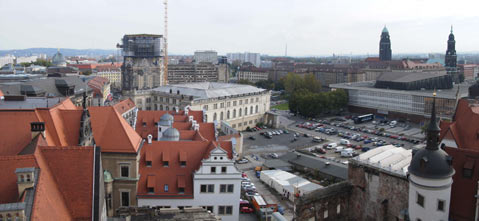|
The
area of the Dresden Neumarkt between the Zwinger and jewish Synagoge,
between the city wall Bruehlsche Terrasse and Altmarkt, was a unique
survival of civic baroque architecture beyond compare in Northern Europe
until its destruction 1945.
The centre of this designated area consisted of an irregular space made
up of three squares: the Jueden hof, the Neumarkt proper and An der
Frauenkirche.
The Neumarkt was crowned by the distincitive dome of the Frauenkirche
built by George Baehr and together with it formed the heart and soul
of Dresden.
Along with the famous buildings of the Saxon Court - including the Zwinger
- the Theaterplatz and the church and houses of the bourgeoisie around
the Royal Palace, the Neumarkt was the peak of architectural and urban
development in Dresden.
During the night of February 13th/14th 1945 the whole town centre was
destroyed together with all the residential buildings in the Neumarkt
area.

In a ideologically turbulent post-war era, the overzealous planning
authorities of the GDR demolished all but a few of the ruins that
remained. With a great amount of personal effort, local conservators
of histrical buildings were able to save precious fragments from the
rubble to integrate from into a future reconstruction.
The Neumarkt remained undeveloped for decades. Not until the nineteen
eighties were the externally unsatisfactory concrete extension of
the police station and the Hilton Hotel - undecided between history
and modern age - ereced.
Even 13 years after the breaching of the Berlin Wall in 1989 the residents
of Dresden and visitors from everywhere still find the neumarkt as a
deserted, unoccupied space. The reconstruction of the Frauenkirche and
the Coselpalais give us to hope for better things.

View from the tower of the City Hall towards the Neumarkt
(08/1999). Centre, the building site of the Frauenkirche surrounded
by scaffolding.
On the left: the Dresden Hilton, the Johanneum and the new Kanzleihaus.
On the right: the police station and the city museum.
|


